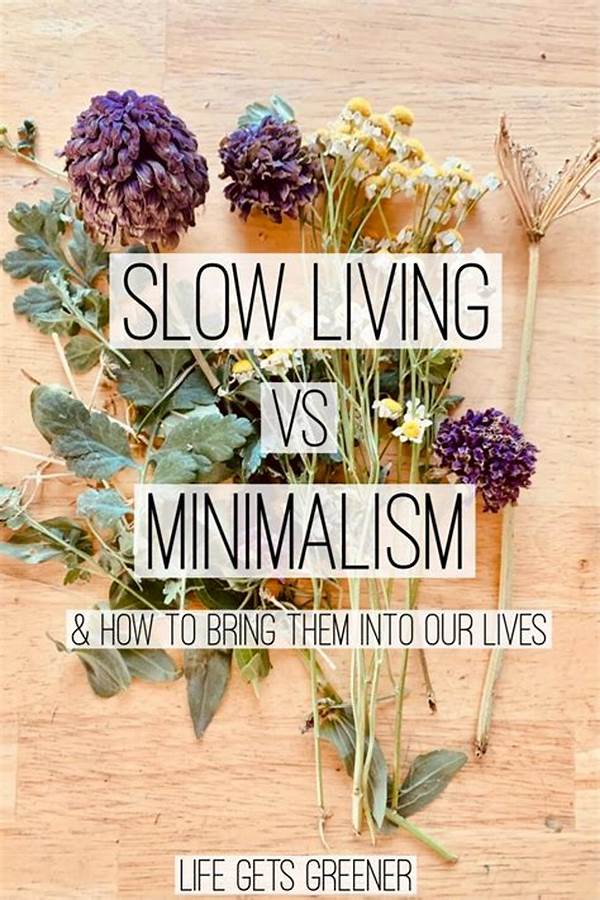How Minimalism Supports Sustainable Living
Read More : Best Minimalist Morning Routines
Minimalism, often portrayed as a lifestyle choice driven by aesthetics, is much more than just clean lines and neutral colors. It’s a powerful tool for promoting sustainable living. The intersection between minimalism and sustainability isn’t just coincidental; it’s a deliberate path many have begun to explore. But how minimalism supports sustainable living exactly? Let’s embark on this journey to unfold the connection, enriched with creativity, humor, and some good old storytelling.
Have you ever felt overwhelmed by clutter? Those shoes you never wear, or that drawer full of gadgets you never use? Enter minimalism—a lifestyle that encourages you to strip away the superfluous and focus on what truly matters. This isn’t about living with nothing; it’s about living with just enough. When you buy less, you consume less, which directly supports the principles of sustainable living. And that, my friends, is how minimalism supports sustainable living. You see, by embracing minimalism, we’re declining the culture of overconsumption, and that’s a big step towards saving the planet, one less item at a time.
Minimalism’s appeal lies in its simplicity and rationality. Imagine a lifestyle where your possessions are intentional, every item serves a purpose, and space isn’t wasted on ‘just in case’ items. This not only declutters your life but reduces waste too—fewer products mean fewer resources used. A minimalistic approach also invites creativity. With limited resources, innovation blooms. People discover that they don’t need fifteen pairs of jeans or replicable, trendy gadgets to find happiness or self-worth. Instead, they find joy in freedom, experiences, and even relationships—things that aren’t mass-produced.
The beauty of minimalism is its versatility. Whether you’re an urbanite living in a studio apartment or residing in a sprawling countryside villa, its principles remain the same: reduce, reuse, recycle. It aligns naturally with sustainable living by encouraging mindful consumption habits. So, how minimalism supports sustainable living is not just by reducing physical clutter but by fostering a mindset of responsibility towards the environment. And who said saving the planet can’t be both chic and fulfilling?
—
The Relationship Between Minimalism and Reduced Waste
In the labyrinth of choices that consumerism presents us with, minimalism shines as a beacon of sustainability. How does it accomplish this feat, you ask? By reducing waste. Let’s delve deeper into this relationship.
Every year, people around the world produce an extraordinary amount of waste. Landfills overflow with discarded goods, from fast fashion items to once-loved electronics. Minimalism tackles this head-on by challenging the ‘buy it, use it, throw it’ cycle. Instead, it invites you to pause and consider: Do I need this? Is this purchase meaningful?
When you adopt a minimalist mindset, you’re not just buying less; you’re buying better. It’s about opting for quality over quantity—choosing durable items that stand the test of time rather than fleeting trends. This mindful consumption reduces not just your personal waste but alleviates the burden on our planet’s resources. Investing in ethically produced, high-quality products, which you’ll cherish longer, aligns perfectly with sustainable living goals.
Consciously choosing sustainable brands and second-hand goods can significantly cut down on waste. The minimalistic mantra of “less is more” resonates loudly in the realm of fashion, pushing for capsule wardrobes with timeless pieces rather than a closet bursting with fast fashion that ends up in landfills. This approach is a testament to how minimalism supports sustainable living by directly lessening environmental impact.
It’s not just about what’s removed from the equation—minimalism also adds value. This lifestyle encourages experiences and memories over material possessions. Imagine swapping a Saturday afternoon of shopping for a hike in nature or a creative workshop. The experiences create impressions that are lasting, often more profound than materialistic satisfaction. It’s this shift in focus from material wealth to experiential wealth that etches the true essence of how minimalism supports sustainable living.
—Tags for Discussion on How Minimalism Supports Sustainable Living
Understanding Minimalism: A Pathway to Sustainable Living
The narrative around minimalism has evolved from a simple interior design choice to a profound lifestyle change that prioritizes sustainability. For many, the first step into this world may seem like an aesthetic leap. However, the underlying goal is far-reaching. At its core, minimalism is about creating space—physically, mentally, and environmentally.
The minimalist movement advocates for eliminating unnecessary excess. It’s like detoxing your life from fast and fleeting trends, mindless purchases, and replaceable gadgets. By doing so, you’re not just making more room in your closet, but also reducing your ecological footprint. Less production demand translates to minimized resource exploitation and waste generation. This is how minimalism supports sustainable living—by aligning our lifestyle choices with the health of our planet.
The attractiveness of minimalism is its accessibility. It’s a movement that doesn’t require a massive upfront investment or a transformative leap in lifestyle. Instead, it encourages gradual changes, starting with simple gestures—like carrying reusable bags, buying fair-trade products, or embracing digital technology to minimize paper waste. Every small step builds upon the other, compounding into significant sustainable outcomes.
Families and communities adopting minimalism often find themselves fostering more meaningful connections. When material possessions take a back seat, communication, creativity, and collaboration rise. Many communities encourage sharing and borrowing over owning, thus promoting a deeper sense of unity. This shift not only benefits individuals on a personal level but paves the way for more sustainable community living.
The future of this movement looks promising as more people become mindful of their environmental impact. Cities and communities across the globe are witnessing a growing interest in minimalist living, which is inspiring sustainable architecture, urban planning, and even workplace designs. By embracing minimalism, we’re setting a global precedent for nurturing a planet-friendly lifestyle.
Minimalism’s Positive Impact on Urban Extinction
An interesting correlation exists between minimalism and urban extinction resistance. In bustling cities where space and resources are limited, adopting a minimalist lifestyle can lead to significant environmental benefits. As cities grow, minimalistic living could be a key player in sustainable urban development, supporting less waste production and reduced energy consumption, thereby maintaining vibrant ecosystems amid urban settings.
Engaging with minimalism today, consequently, becomes more than just a lifestyle choice—it’s an environmental imperative. Our choices today determine our legacy for generations, that’s the ripple effect of how minimalism supports sustainable living. So why not bring a little minimalism into your life? It’s not only a trend but an opportunity for impactful change.
Exploring Depths: Minimalism as a Catalyst for Change
In conclusion, minimalism is not just about curbing waste or cutting expenses. It’s about fueling a shift in consciousness. It’s an invitation to reflect on our deepest values and make choices that align with sustainable practices. By choosing minimalism, we are choosing a life of conscious deliberation, cherishing what truly matters, and ultimately, giving back to a planet that has given us so much.
So, are you ready to embrace the minimalist lifestyle and be part of this sustainable revolution? Remember, every action counts, no matter how small. Let’s make mindful choices together and witness the profound difference of how minimalism supports sustainable living.
—
Tips for Embracing Minimalism for Sustainable Living
Description of How Minimalism Supports Sustainable Living
Minimalism isn’t just a fleeting Pinterest board favorite; it’s an impactful lifestyle that nurtures wellness for individuals and the planet alike. This approach reduces the incessant need to consume, paving the way for actions that genuinely resonate with sustainable living. You buy less, waste less, and cherish more. It’s a refreshing rebellion against the culture of excess.
Imagine the liberation that comes with a clutter-free life—mentally and physically. Life becomes less about things, and more about experiences and relationships. A minimalist approach also creates room for reflection and personal growth. It promotes an equilibrium between what you have and what you truly need.
Moreover, adopting such a lifestyle can guide you toward becoming a conscientious global citizen. With less demand for consumer goods, the planet breathes a little easier. Less clutter means fewer resources expended for production, resulting in lowered carbon emissions. The ripple effect of this thoughtful consumption trickles down to ensuring environmental conservation and, ultimately, a sustainable Earth for generations to come.
The Minimalist Path: A Way Forward
Minimalism as a lifestyle choice brings a plethora of benefits. Not only does it allow for practical simplicity, but it empowers individuals to act with sustainability in mind. Each choice—be it purchasing, consuming, or disposing—is weighed against its environmental impact. As more people embrace this, it’s no wonder that the minimalist movement is on a trajectory poised to revolutionize the way we live.
Minimalism: A Journey to a Sustainable Future
As we navigate the demands of modern life, we’re often tempted to succumb to the allure of owning more. However, minimalism teaches us that scaling back can actually yield more—more peace, more financial freedom, and a healthier planet. This rhythmic dance between having and being is the cornerstone of how minimalism supports sustainable living. And spoiler alert: it’s a journey worth embarking upon.


